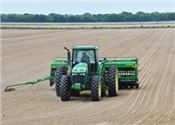|
Farmers Still Planting Soybeans Despite COVID-19

A farmer plants soybeans in a field in Acadia Parish. Farmers are expected to plant approximately
900,000 acres of soybeans across Louisiana in 2020. Dry conditions in the southern part of the state are
slowing down planting, while wet conditions in thenorth Louisiana are keeping farmers from getting
into their fields.
Photo by Bruce Schultz/LSU AgCenter
BATON ROUGE, LA.
Soybeans are Louisiana’s largest crop in terms of acreage, and farmers across the state are busy planting this year’s crop despite the challenges of COVID-19.
“About 10 percent of the state has been planted,” said LSU AgCenter state soybean specialist David Moseley. “We’re a little behind where we were last year, but we are right on the five-year average.”
Pointe Coupee farmer George Lacour intends to plant 2,400 acres of soybeans this year. “So far, we have 600 acres planted.” Lacour said.
Lacour said moisture levels have been adequate in his area for planting, but it is trending drier. However, he said seepage from a high Mississippi River is an issue for fields bordering the levee.
Warm weather has helped dry some fields and allowed Lacour to repair rutted fields from last year.
“The warm weather has definitely helped,” Lacour said. “I’ve got the best stand of corn right now that I have had in the last 10 years.”
North Louisiana farmers are having more issues with wet ground, which has slowed planting there. In the southern part of the state, some farmers are waiting for rain before resuming planting.
According to the U.S. Department of Agriculture, Moseley said, planting intentions for soybeans in Louisiana is 980,000 acres, approximately a 10 percent increase from last year’s acreage.
In speaking with some AgCenter agents in soybean-producing parishes, Moseley’s figures are slightly lower than the USDA numbers.
“We’re estimating around 850,000 acres,” Moseley said, “which would be very similar to last year’s crop.”
These numbers could change. Weather could prevent some acres from being planted, or an increase in the price for soybeans could cause an increase in acreage.
Nationally, the USDA is estimating a 10 percent increase, which would be in line with the increase it is forecasting for Louisiana. Total soybean acreage nationally is expected to be 83.5 million.
A few years ago, Louisiana grew nearly 1.4 million acres. A disastrous harvest season in 2018 and a trade spat with China, the major importer of U.S. grown soybeans, has reduced the appetite for growing soybeans, both in Louisiana and the U.S.
The optimum window for planting soybeans in Louisiana is April 10 to May 10. Late-planted soybeans usually produce lower yields, Moseley said.
“Day length plays a major role in soybean production,” Moseley said. “Shorter days result in less vegetative growth, which in turn leads to reduced photosynthesis.”
Less vegetative growth also does not close the canopy. Holes in the canopy allow sunlight to get in, which encourages weed growth and increases evaporation of soil moisture. Both of these can lead to lower yields.
This year is Moseley’s first as the AgCenter state soybean specialist. He arrived in January and began attending producer meetings to introduce himself to members of the farming community.
“That really helped me identify who I will be working with,” he said.
Moseley said the COVID-19 situation has not affected his research efforts. He plans to have 158 entries in the official variety trials and 26 core-block trials. Moseley also plans to have small-plot research looking at elite germplasm, planting dates, plant populations and fertility. ∆
|
|